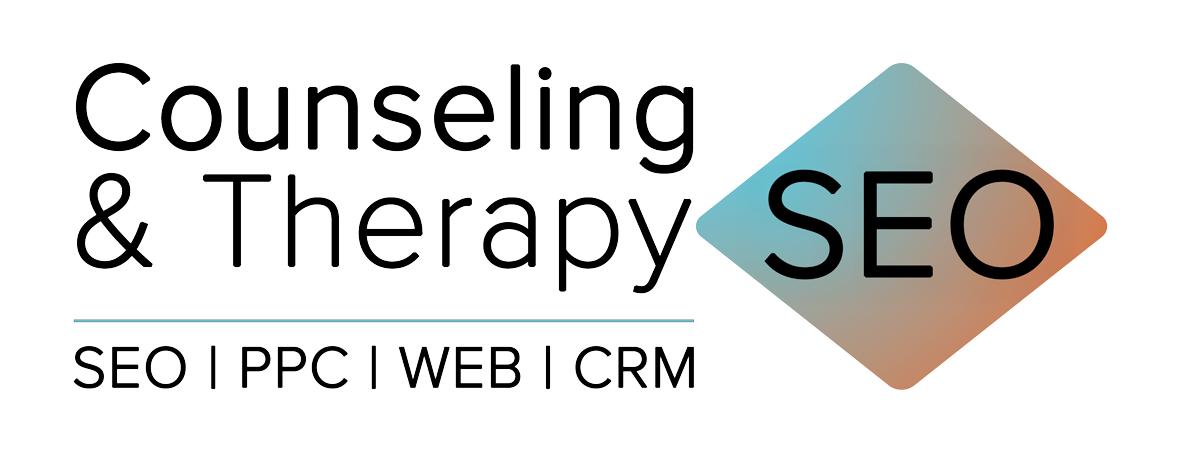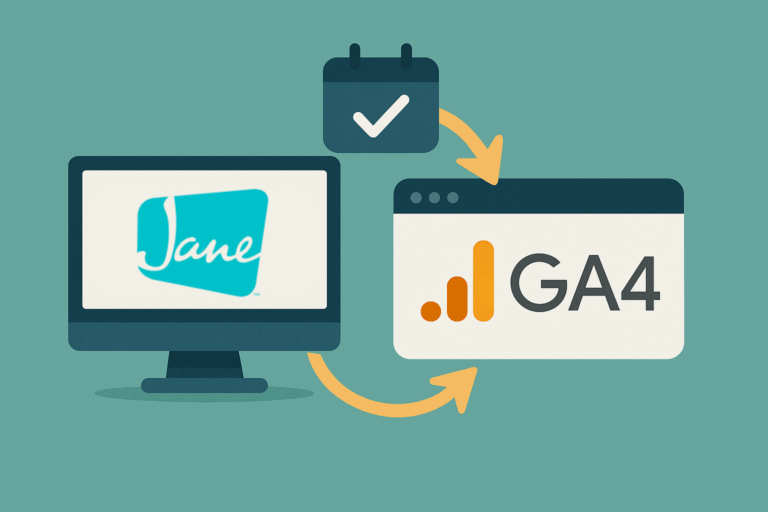The DIY Illusion
“If I do my own marketing, I’ll save money.”
That’s the story many private practice owners tell themselves. On paper, it makes sense. Why pay someone else when you can tinker with your own website, write a blog post, or boost a Facebook ad?
But here’s the hidden math:
If your billable rate is $150 to $200 per session, every hour you spend on DIY marketing isn’t just $0. It’s closer to minus $150 per hour. You’ve lost the income you could have earned with a client, and you’ve “paid yourself” in wasted time. That time is spent on tasks outside your expertise, plus the cost of ads, software, and courses that rarely deliver results.
And the worst part? You end up staying up late wrestling with Canva or WordPress while your clinical notes pile up and your stress level spikes.
Most therapists already lose a big chunk of their week to unpaid admin. Scheduling, billing, charting, and insurance take their toll. For clinic owners, the load is even heavier. Managing staff, payroll, and overhead sit on top of everything else. Adding DIY marketing into that mix doesn’t just increase work. It eats into your most valuable and irreplaceable asset: time.
Unlike billing or charting, marketing is a high-skill discipline. A few scattered hours here and there rarely lead to results. Instead, it stretches you thinner, creates frustration, and keeps your clinic invisible online.
And that brings us to the part most owners never calculate: the hidden time cost.
The Time Cost You Don’t See
As a therapist, you don’t sell products. You sell time.
Every session you or your team hold is directly tied to revenue. But every non-billable task such as billing, scheduling, managing payroll, fiddling with the website, or running ads steals hours that don’t generate income.
Look at your own week: how many hours are truly billable? A simple time audit often shows that half of a clinician’s week is swallowed by unpaid admin. (See chart: billable vs non-billable hours.)
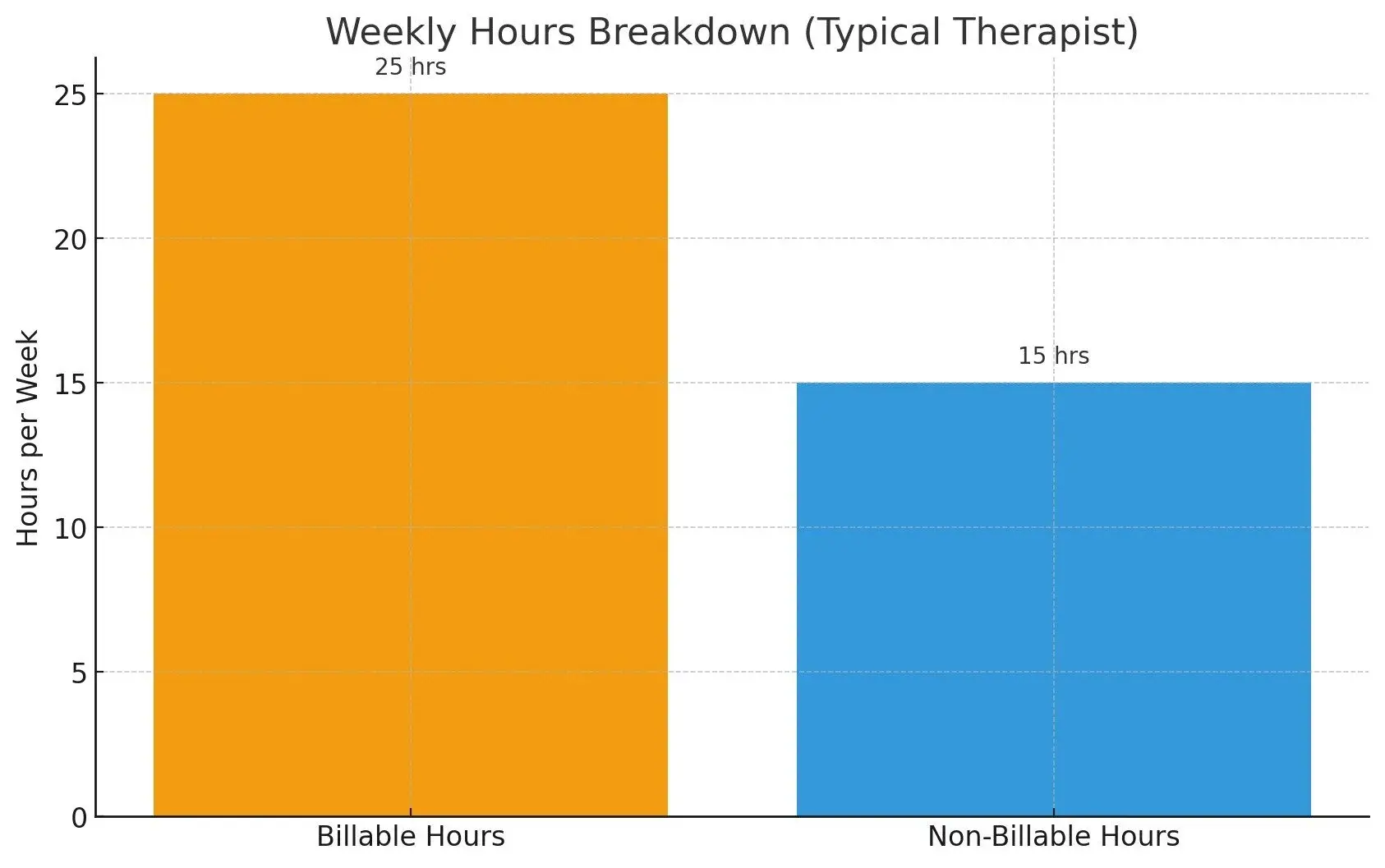
For solo practitioners, the burden is obvious. For clinic owners, it is sneakier. You might see fewer clients yourself, but you trade that time for managing staff and operations. Either way, the math is the same: less time in session (or leading the business strategically) means a lower effective hourly income.
You might think you’re earning $150 to $200 per hour, but once you subtract the hours lost to admin and DIY marketing, your “true” hourly rate shrinks fast. Sometimes it is cut in half.
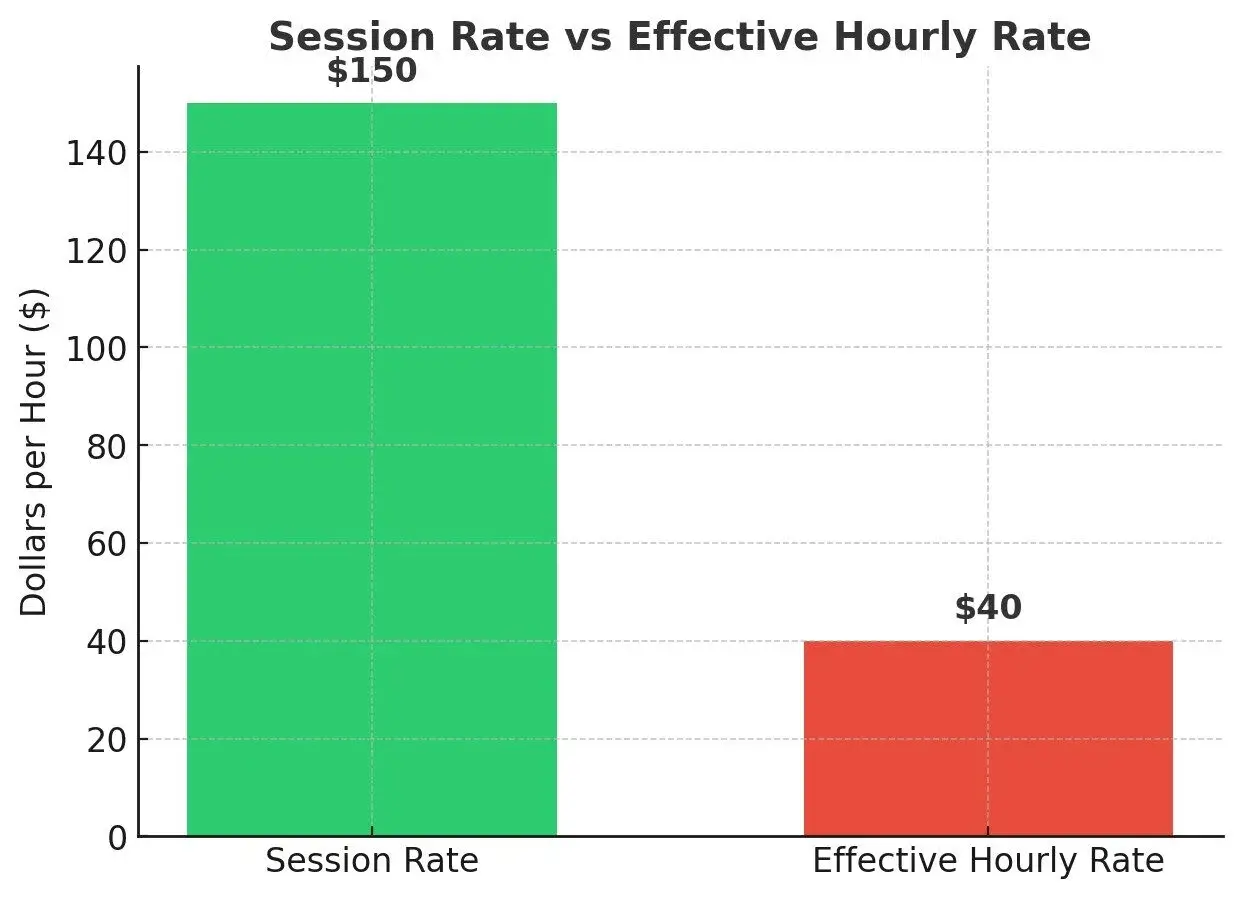
That’s the hidden drag that keeps so many practice owners stuck: working harder, managing more, yet never feeling like they’re moving ahead.
So what’s the solution? You don’t need to do it all yourself. The best practice owners know their strengths and delegate the rest.
Here are the common areas to offload so you can focus on what you do best:
- Admin & scheduling: answering phones, managing calendars, sending reminders
- Billing & insurance: submitting claims, chasing reimbursements, processing payments
- Bookkeeping & payroll: tracking revenue, paying staff, managing expenses
- Client intake & follow-up: responding quickly to new inquiries, making sure no leads slip through
- Digital marketing & SEO: keeping your clinic visible online, running Google Ads, optimizing your site
- Technology support: website updates, EHR troubleshooting, software setup
- Office operations: supplies, rent, utilities, vendor management
The truth is, when you hold onto everything, you cap your clinic’s growth. Delegation isn’t a luxury. It is how you reclaim your time, protect your income, and give your team (or trusted partners) the responsibility to keep things moving.
But even with delegation, one myth keeps owners trapped: the idea that “more clients” will solve everything.
Why “More Clients” Alone Backfires
Most practice owners assume the answer to their problems is simple: “If I just get more clients, the money will work itself out.”
But a full calendar without systems doesn’t solve the problem. It makes it worse.
More clients means more admin. More billing. More cancellations to reschedule. More pressure on your intake process. Without the right structure, adding volume only adds chaos. And chaos leads to self-sabotage: you respond slower, you delay follow-ups, and you do less marketing activity. Ironically, you create the very slump you were trying to avoid.
And the biggest leak of all? Leads that slip away.
- Calls that go unanswered
- Emails that sit in the inbox too long
- Voicemails that never get returned
In therapy practices, missed calls and slow responses are the silent killer of ROI. Marketing dollars don’t fail because the strategy was wrong. They fail because no one picked up the phone.
Here’s what that looks like in real terms: imagine a small clinic with three clinicians. They miss just five calls in a single month.
Now let’s do the math together:
- On average, a new client comes in for about 13 sessions a year
- At a typical private-pay rate of $150 per session, that means each new client is worth about $1,950 per year
- Many clients stay for more than a year, so their lifetime value is often much higher
If half of those five missed calls (let’s say two or three of them) could have turned into real clients, that’s $3,900 to $5,850 in the first year alone. If even one of those clients stayed for two years, that single missed call could represent nearly $4,000 in lost revenue. Add it up across multiple months, and you’re looking at $10,000+ in lost client lifetime value every year simply because no one picked up the phone in time or responded quickly enough.
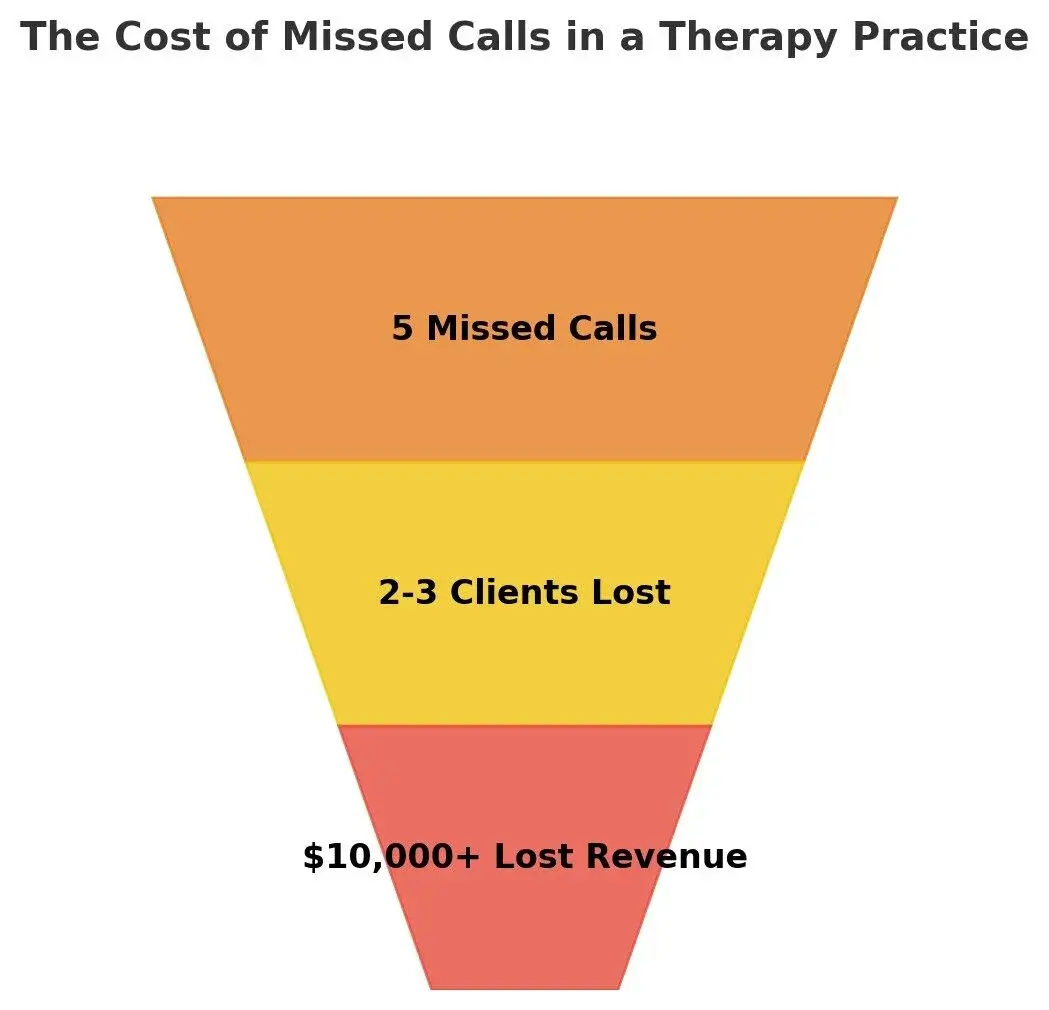
Until those systems are fixed, “more clients” is just more stress. Growth without infrastructure leads to burnout for you and for your staff because you’re constantly riding the highs and lows of putting out fires.
What you really need isn’t just more clients. You need a steady machine that delivers predictable leads, filters for the right clients, and keeps the whole practice moving forward. That way, you can stay focused on what you do best: helping people.
And that machine is built on one thing: treating marketing as an investment, not an expense.
Marketing Is an Investment, Not a Cost
Most practice owners treat marketing like an expense. Something you “shouldn’t have to pay for” if you’re good enough at what you do.
But in reality, marketing is how you buy back your time. And the way to decide if it’s worth it isn’t gut feel. It’s math.
And you don’t need to take my word for it.
The math makes it clear.
Step 1: What a Client Is Worth (CLV)
This is called Client Lifetime Value. It is the total revenue one new client brings to your practice.
- The average client attends about 13 sessions per year
- At $150 per session, that adds up to $1,950 per year
- If a client stays for two years (not uncommon), that’s nearly $4,000 from a single client
Step 2: What It Costs to Get That Client (CAC)
This is Client Acquisition Cost. It is the money you spend to bring in a new client.
- In healthcare, a lead from search ads usually costs around $35 to $75
- If about 30% of those leads become a paying client, your CAC is roughly $115 to $250 per client
Step 3: Compare the Two
- Spend $250
- Gain a client worth $1,950 in year one (and often much more)
- That’s an 8:1 return on investment
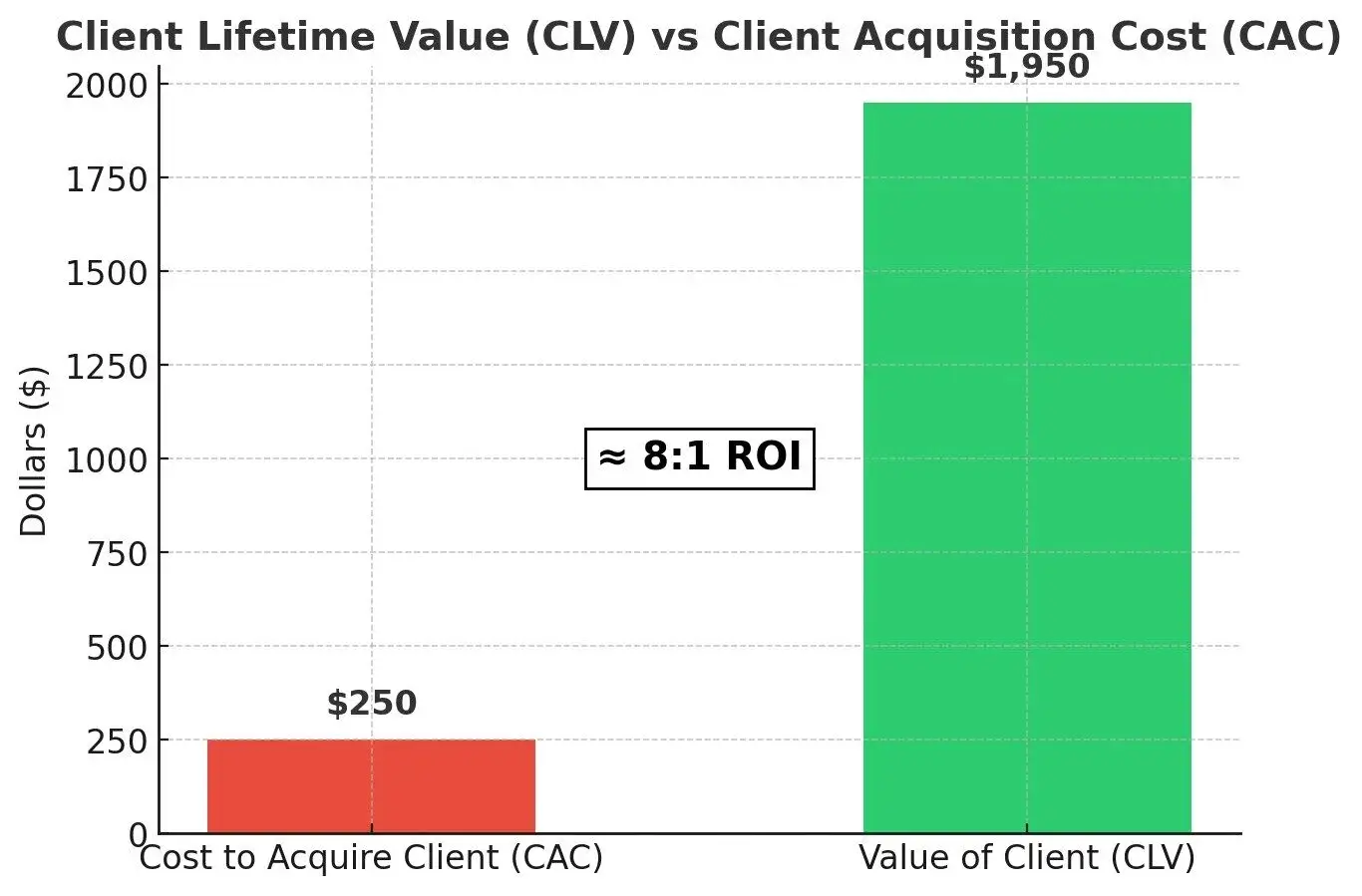
Step 4: What That Means for You
This is why marketing isn’t a cost. It is an investment. One solid client can more than cover your monthly marketing spend. Everything after that is profit, predictability, and peace of mind.
Instead of guessing, stressing, or patching together DIY tactics, you can have a machine that steadily turns marketing dollars into the right clients for your practice.
Put another way: one solid client more than pays for the cost of marketing.
Said another way: you pay $250 and get $1,950 back.
In most industries, a 3:1 return is considered healthy. In counseling, the math often works out closer to 7:1 or even 8:1. That’s almost triple the return—and it means your field is uniquely positioned to grow if you stop guessing and start treating marketing like the growth engine it is.
When you have a system that brings in a steady stream of the right clients, you don’t just make your money back. You reclaim your calendar, reduce stress, and create predictable growth for your team.
But here’s the challenge: therapists face ethical and legal restrictions most businesses never think about.
The Ethical Path to Visibility
If you’ve been in private practice for any length of time, you already know the rules are different for therapists.
- No discounts or “first session free” promos
- No actively soliciting reviews or testimonials from clients.
- No gimmicky referral rewards or contests
That can make marketing feel like a minefield. But here’s the good news: you don’t need gimmicks to attract clients. What works best for therapists is educational, trust-building marketing.
Here are the pillars that keep you visible and ethical:
- Local SEO with a complete Google Business Profile (GBP): when someone searches “therapist near me,” you want to appear in the 3-Pack on Google Maps. That is the modern-day front door of your practice
- Clear service and condition pages: pages for anxiety counseling, couples therapy, trauma therapy, and other specialties. These pages answer real questions, build trust, and show prospective clients you understand them
- Educational blogs and short videos: think “What to expect in your first therapy session” or “How to cope with holiday stress.” This isn’t sales copy. It is content that builds authority and connection long before a client ever calls you
Ethical marketing isn’t about chasing people down. It’s about showing up where they’re already searching, and giving them reasons to trust you enough to take the next step.
So if ethical marketing is the way forward, what happens if you try to do it yourself?
Why DIY Underperforms
On the surface, doing your own marketing feels scrappy and resourceful. But in practice, DIY almost always underdelivers.
If you don’t have a marketer, guess what? You’re the marketer. And you’re probably overpaid for the job and not even very good at it.
That’s not a dig. It’s simply the truth: you trained for years to be a therapist, not to run Google Ads or master SEO. Every hour you spend fumbling through marketing tasks is an hour you’re paying yourself $150 to $200 to do work you were never meant to do.
Here’s why DIY consistently falls short:
- Directories dominate search results. Sites like Psychology Today and Zencare often take the top spots. Without a smart SEO strategy, your clinic is buried beneath them, and you end up paying rent on their platform instead of owning your own visibility
- Health ads face stricter rules. Google and Meta limit audience targeting for mental health services. Ads often get flagged as “Eligible (Limited),” which means fewer impressions, higher costs, and no retargeting. Without expertise, it’s easy to waste money fast
- Tracking is complicated. HIPAA and state privacy laws restrict the way you can use pixels, analytics, and forms. Set things up wrong, and you risk not only wasted data but compliance headaches
- Time is still your scarcest resource. Even if you manage to run ads or tweak your website, every hour you spend is an hour not spent seeing clients, supporting your staff, or building your practice. The opportunity cost stacks up quickly
DIY marketing isn’t just inefficient. It’s expensive. You burn time, miss opportunities, and stay stuck competing on someone else’s terms.
The alternative? Work with a specialized agency that already knows what works for counseling practices.
What a Specialized Agency Gives You
The right marketing partner gives you more than tactics. They give you a system built for therapy practices:
1. A Website That Converts
Most DIY websites end up as little more than digital brochures. They are clunky, generic, and easy for visitors to click away from. The right website should feel like an extension of your office: clean, calming, and professional. It reassures potential clients they’re in the right place and guides them toward one clear action: booking an appointment.
2. SEO & GEO That Make You Discoverable
Clients don’t flip through directories anymore. They search. And if your site doesn’t show up, directories like Psychology Today and Zencare will take that traffic instead. Strong SEO ensures that when someone types “anxiety therapist near me,” your clinic appears in the results. With Google and AI-driven search tools now shaping how people find care, being discoverable online isn’t optional. It’s essential.
3. Local Maps Domination
Most people don’t scroll down the page. They click one of the first three results in Google Maps. That’s where most inquiries begin. A fully optimized Google Business Profile with photos, services, hours, and reviews can place your practice in that coveted 3-Pack and capture the calls that would otherwise go to someone else.
4. Google Ads That Work
Search engine optimization is a long game. Ads deliver right away. But without the right setup, ad budgets evaporate quickly. Effective campaigns target high-intent searches like “therapist near me” or “couples counseling [city],” putting your practice in front of the right people at the right time. Ads bridge the gap, bringing in immediate inquiries while SEO builds lasting visibility. That’s why steady-growth practices budget about 6–8% of revenue for marketing, and aggressive-growth clinics invest closer to 10%.
5. CRM & Automation That Save Time
This is where many clinics leak money. Missed calls, slow responses, and scattered intake systems mean potential clients slip away before they’re ever booked. A good CRM solves that problem by pulling calls, texts, and emails into one inbox, automating follow-ups, and tracking leads through a simple pipeline. The result: fewer lost opportunities, less manual admin, and more time for you and your clinicians to focus on clients.
With these five systems in place, you’re no longer overpaying yourself to play the marketer. Instead, your practice has a predictable growth engine running in the background. It keeps your calendar steady, lowers your stress, and lets you focus on the work that matters most.
Which brings us to the final step: taking action before another month slips by.
Reclaim Your Time
The real cost of DIY marketing isn’t just the wasted hours. It’s the clients who never call back, the income that slips away, and the stress of always feeling behind. Every time you try to do it all yourself, your effective hourly wage drops, and your practice stays stuck in survival mode.
Ethical, strategic marketing is how you protect your time, steady your calendar, and grow your practice without burning out.
You became a therapist to help people, not to play marketer, bookkeeper, and receptionist all at once. The business side doesn’t have to feel like a second job.
If you’re ready to reclaim your week, attract the right clients, and finally have a system you can trust, this is exactly what we help therapy clinics build.
Book your free strategy session with CounselingSEO.com and see how simple growth can be when you don’t have to be the marketer anymore.
